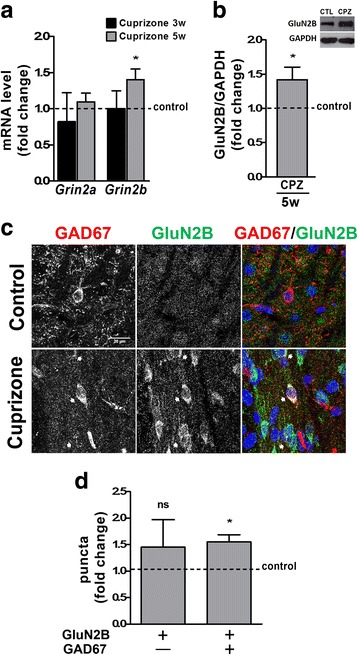Fig. 6.

Cuprizone treatment leads to an increase in the NMDAR subunit GluN2B within the dorsal lateral geniculate nucleus (dLGN). a Bar graph depicting mRNA levels for NMDAR subunits GluN2A (Grin2a) and GluN2B (Grin2b) as determined by RT-qPCR analysis at 3 (3w) and 5 (5w) weeks of cuprizone treatment. n = 6: Grin2a control and cuprizone 3w and 5w; n = 7: Grin2b control and cuprizone 3w and 5w. b Bar graph illustrating protein levels for the NMDAR subunits GluN2B at 5 weeks of cuprizone treatment. GAPDH protein levels were used for normalization. A representative Western blot is shown in the inset (upper right). n = 5: Control (CTL) and Cuprizone (CPZ). c Representative confocal images depicting immunostaining for the NMDA receptor subunit GluN2B (middle panels) and glutamic acid decarboxylase 67 (GAD67) as a marker for inhibitory neurons (left panels) in the dLGN at 5 weeks of cuprizone treatment (lower panels) or under control conditions (upper panels). Arrows in the lower panels indicate cells labeling positive for both GAD67 and GluN2B. Scale bar: 20 μm. d Bar graph illustrating the number of GluN2B-positive puncta co-localizing with GAD67 at 5 weeks of cuprizone treatment. 2 fields per slice and 2 slices per animal (n = 4: Control; n = 5: Cuprizone) were analyzed. All bar graphs depict means ± SEMs. *p < 0.05, **p < 0.01, ***p < 0.001, not significant (ns) p ≥ 0.05 (one-sample t test; compared to set control value = 1)
